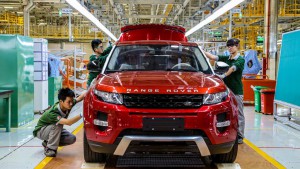That “veddy” British automaker, Jaguar Land Rover, is looking a little less Anglo-Saxon every day. First, it was acquired by American maker Ford, then sold to Indian upstart Tata Motors. And now, JLR has opened up its first foreign manufacturing plant. In China, of course.
The Asian nation is already the world’s largest automotive market and, by most accounts, is expected to top the global luxury sales charts, as well, by the end of the decade. It is, in fact, already Jaguar Land Rover’s single-largest market.
And the maker is expecting to see that grow significantly, in part, because localizing production will eliminate the hefty Chinese tariff on automotive imports.
As with other foreign-based manufacturers, JLR was required to find a local Chinese partner to team up with. It formed a joint venture with Chery Automobile Company Ltd., a company better known for its entry-level models, such as the pint-sized QQ. (Based on an old Korean Daewoo model, Chery was locked in a long legal battle with General Motors, which accused the Chinese firm of stealing the design.)
The new Chery Jaguar Land Rover Automotive Company spent the last two years putting up its nearly 5 million square-foot factory in Changshu, about 60 miles outside of Shanghai, one of China’s main automotive manufacturing centers. That gives the joint venture ready access to the existing supplier base but may help hold down the rapid wage hikes that have been hitting plants closer to Shanghai.
Part of a broader, $1.8 billion investment plan, the new factory is expected to eventually produce three different JLR models, though prototype production has just launched with the Range Rover Evoque. By 2016, the partners expect to be rolling out as many as 130,000 vehicles annually.
In keeping with JLR’s shift to use lightweight materials, the new factory is equipped to handle both steel and more advanced aluminum pressings. And where many Chinese plants have emphasized manual labor due to relatively low labor costs, the new steel body shop alone has 306 robots.
The aluminum body shop, now under construction, will be the first of its kind in China.
(Land Rover barges into Paris with new Discovery Sport. For more, Click Here.)
JLR sold 100,000 vehicles in China last year, and the maker is looking to the Asian nation to help it regain the momentum it lost in the years leading up to the global economic downturn.
(Click Here for details about China’s concern about indigenous auto brands.)
But the two British brands are still minor players when compared to the dominant German marques – Audi currently is the best-selling luxury nameplate in China.
(To see more about the issues facing China and its auto segment, Click Here.)
The launch of JLR production comes at a time when the Chinese economy, in general, has been softening, though most analysts expect its luxury market to continue growing rapidly over the next decade.
That has encouraged all manner of manufacturers to enter the fray, including Cadillac which only recently launched production of its own models in China. Struggling Lincoln, meanwhile, just began opening up its own dealer network in China which it also hopes could eventually become one of its largest market.

